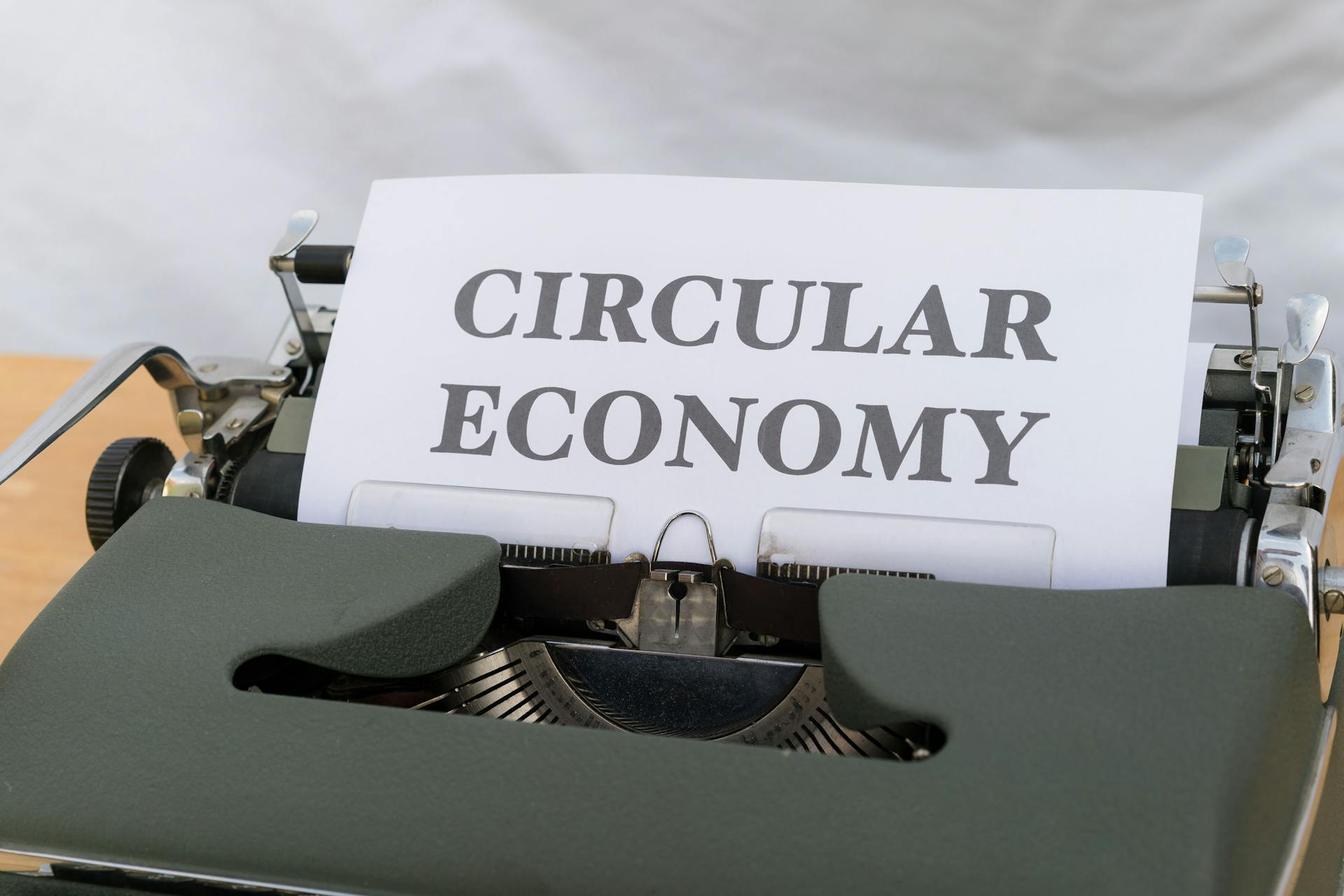
The reinsurance market is constantly evolving, with trends and insights that can help you make informed decisions.
The global reinsurance market is expected to grow by 5% annually between 2020 and 2025, driven by increasing demand for insurance coverage in emerging markets.
Reinsurance companies are shifting their focus towards emerging markets, where growth opportunities are vast and untapped. This is evident in the growing number of reinsurance deals in countries like China and India.
The COVID-19 pandemic has accelerated the adoption of digital technologies in the reinsurance industry, with more companies investing in data analytics and artificial intelligence to enhance their operations.
Here's an interesting read: Emerging Market Credit
Definition
Reinsurance is essentially a form of insurance for insurance companies. It provides financial protection to insurers in case they face large claims.
The reinsurance market helps to share risk between primary insurers and reinsurers, allowing them to manage their exposure more effectively. This is achieved through the transfer of risks from primary insurers to reinsurers.
Broaden your view: What Are Reinsurers
Reinsurance can take various forms, including proportional and non-proportional contracts. Proportional contracts, such as coinsurance, involve the sharing of losses between the insurer and reinsurer.
The reinsurance market is a global industry, with companies operating in multiple countries and regions. The size and scope of the reinsurance market can have a significant impact on the stability of the global insurance industry.
Intriguing read: Insurance Industry Combined Ratio
Benefits and Functions
Reinsurance gives insurers more security for their equity and solvency by increasing their ability to withstand financial burdens from unusual events.
Insurers are legally required to maintain sufficient reserves to pay all potential claims from issued policies.
Reinsurance allows insurers to underwrite policies covering a larger quantity of risk without excessively raising administrative costs to cover their solvency margins.
Almost all insurance companies have a reinsurance program to reduce their exposure to loss by passing part of the risk of loss to a reinsurer or a group of reinsurers.
Through reinsurance, insurers may have substantial liquid assets available to them in the event of exceptional losses.
Additional reading: Excess of Loss Reinsurance
Types of Reinsurance

Reinsurance is a complex and multifaceted industry, but at its core, it's a way for insurance companies to manage risk and protect themselves against potential losses.
There are two main types of reinsurance: treaty and facultative. Treaty reinsurance covers broad groups of policies, such as all of a primary insurer's auto business, whereas facultative reinsurance covers specific individual risks, such as a hospital.
Facultative reinsurance is typically used for high-value or hazardous risks that wouldn't be acceptable under a treaty. It's a more customized approach to reinsurance, where the reinsurer holds all the rights for accepting or denying a proposal.
Here are some key characteristics of treaty and facultative reinsurance:
Proportional reinsurance, on the other hand, involves the reinsurer taking a stated percentage share of each policy issued by the insurer. This can be a quota share arrangement, where a fixed percentage of each policy is reinsured, or a surplus share arrangement, where the ceding company retains a certain amount of each risk before reinsuring the excess.
Check this out: Share Market Phonepe
Proportional

Proportional reinsurance is a type of arrangement where one or more reinsurers take a stated percentage share of each policy that an insurer issues. This share is usually expressed as a percentage of the premiums and claims.
Under a quota share arrangement, a fixed percentage of each insurance policy is reinsured. For example, 75% of each policy might be reinsured, allowing the ceding company to retain some of the profits on the business via the ceding commission.
The ceding company may seek a quota share arrangement to increase their capacity to sell more business. By reinsuring 75% of their business, they can sell four times as much and retain some of the profits.
The ceding company may also seek surplus reinsurance to limit their losses from a small number of large claims. This type of arrangement is also known as surplus of line or variable quota share treaty.
In a surplus reinsurance arrangement, the ceding company decides on a "retention limit" and reinsures the excess over this limit. For example, if the retention limit is $100,000, the ceding company retains the full amount of each risk up to this limit, and the excess is reinsured.
Curious to learn more? Check out: Policyholder Surplus
A quota share arrangement may be combined with a surplus share arrangement, or a combination of the two. The ceding company may choose this type of arrangement to manage their risk and increase their capacity to sell business.
Here's a breakdown of the types of proportional reinsurance arrangements:
In a 9 line surplus treaty, the reinsurer would accept up to $900,000, with the ceding company retaining all the premiums and losses from policies up to $100,000.
Non-Proportional
Non-Proportional reinsurance is a type of reinsurance where the reinsurer only pays out if the total claim(s) suffered by the insurer exceed a stated amount, known as the "retention" or "priority".
This type of reinsurance is often used when the insurer wants to limit its exposure to large losses. For instance, an insurer may be prepared to accept a total loss up to $1 million and purchases a layer of reinsurance of $4 million in excess of this amount.

The main forms of non-proportional reinsurance are excess of loss and stop loss. Excess of loss reinsurance can have three forms - "Per Risk XL" (Working XL), "Per Occurrence or Per Event XL" (Catastrophe or Cat XL), and "Aggregate XL".
Per risk excess of loss reinsurance is used when the cedent's insurance policy limits are greater than the reinsurance retention. For example, an insurance company might insure commercial property risks with policy limits up to $10 million, and then buy per risk reinsurance of $5 million in excess of $5 million.
Catastrophe excess of loss reinsurance is designed to protect the cedent against catastrophic events that involve more than one policy. For example, an insurance company issues homeowners' policies with limits of up to $500,000 and then buys catastrophe reinsurance of $22,000,000 in excess of $3,000,000.
Aggregate XL affords a frequency protection to the reinsured. For instance, if the company retains $1 million net any one vessel, $5 million annual aggregate limit in excess of $5m annual aggregate deductible, the cover would equate to 5 total losses (or more partial losses) in excess of 5 total losses (or more partial losses).
Recommended read: Equity Market Risk
Reinsurance Market Overview

The reinsurance market is a vital part of the insurance industry, allowing companies to transfer risk to another company and reduce the likelihood of large payouts for a claim. This practice, known as reinsurance, has been around for a while and is used by many insurance companies to remain solvent.
Reinsurance occurs when multiple insurance companies share risk by purchasing insurance policies from other insurers to limit their own total loss in case of disaster. This is a common practice, especially for large events like hurricanes that can cause billions of dollars in damage.
The global life reinsurance market is dominated by the North American and European markets, accounting for over 80 percent of the global market. The Asia-Pacific region is also growing rapidly, and is expected to reach 20-25 percent of the global market by 2020.
Here are some key statistics about the top five players in the global life reinsurance market:
- Gross written life reinsurance premiums amounted to $76.2 billion globally in 2016, a 0.7 percent increase over 2015.
- The top five players hold over 71 percent of market share.
- The compound annual growth rate (CAGR) was 4.2 percent between 2009 and 2016.
Global Market
The global reinsurance market is a complex and dynamic industry. In 2016, gross written life reinsurance premiums amounted to $76.2 billion globally, a 0.7 percent increase over 2015.
The top five players dominate the global life reinsurance landscape, holding over 71 percent of market share. They are likely to maintain their dominance, especially in the highly concentrated developed markets, despite growth opportunities for some smaller, new or regional players.
The life reinsurance industry is dominated by the North American and European markets, accounting for over 80 percent of the global market. The Asia-Pacific region currently represents about 18 percent of the global market, but this share of premiums has been steadily increasing over the years.
The top five reinsurers have increased their gross premium written despite a competitive and difficult market environment. This is mainly due to selective growth opportunities across a few product lines and demand emerging from the developing markets, especially Asia.
You might enjoy: Future of Life Insurance Industry
Here are the top five reinsurers in the global life reinsurance market:
The global reinsurance market is expected to grow by about 3 percent to 5 percent on a gross written premium basis in the next couple of years. This growth will be driven by emerging markets, particularly in Asia.
Risks Attaching Basis
Risks Attaching Basis is a key concept in reinsurance that helps insurers manage their risk exposure.
The basis under which reinsurance is provided is called "risks attaching basis." This means reinsurance is provided for claims arising from policies commencing during the period to which the reinsurance relates.
The insurer knows there is coverage during the whole policy period, even if claims are only discovered or made later on.
All claims from cedent underlying policies incepting during the period of the reinsurance contract are covered, even if they occur after the expiration date of the reinsurance contract.
Any claims from cedent underlying policies incepting outside the period of the reinsurance contract are not covered, even if they occur during the period of the reinsurance contract.
This basis helps insurers provide coverage for their clients, knowing that they have a safety net in place to cover potential losses.
Regional Markets
The European reinsurance market is a complex and diverse landscape. Europe, the Middle East, and Africa account for a significant portion of the global life reinsurance business, with the U.K., France, Germany, and Italy jointly accounting for over 70 percent of total life premiums.
Mature Western European markets remain the primary source of life reinsurance business, but reinsurers are now looking at smaller and less penetrated countries in Central and Eastern Europe. This is driven by the expansion of direct insurance markets and increased demand for risk transfer.
The aging population in Europe presents opportunities for long-term care, longevity, and other nontraditional products. These include critical illness or disability insurance, which are gaining traction.
Here are some key opportunities in the European market:
- Exploring alternative products to traditional covers;
- Increased focus on biometrical products (term life, disability and health insurance), as well as on fee business and asset management;
- Private pension market on the verge of exponential growth as retirement planning solutions of most major European Union countries are considered inadequate.
Solvency II, which came into effect in Europe in 2016, is expected to create near-term business opportunities as reinsurance may be one of the few options available to insurers needing to improve their capital positions quickly.
Frequently Asked Questions
Who are the big four reinsurers?
The big four reinsurers are Swiss Re, Munich Re, Hannover Re, and SCOR, who dominated the global reinsurance market in 2023 and 2024. These four companies are known for their strong financial performance and discipline in the hard reinsurance market.
Who is the biggest reinsurance company?
Munich Re is the largest reinsurance company in the world, with net premiums written of approximately 48.6 billion U.S. dollars in 2022. It outperformed Swiss Re, the second-largest reinsurer, by over 11 billion U.S. dollars that year.
What is the reinsurance market outlook for 2024?
The global reinsurance market is expected to grow in 2024, with a 5.4% increase in dedicated capital to USD766 billion. This growth is driven by both traditional reinsurers and non-life alternative capital sources.
Sources
- https://www.investopedia.com/terms/r/reinsurance.asp
- https://en.wikipedia.org/wiki/Reinsurance
- https://www.rgare.com/knowledge-center/article/global-life-reinsurance-industry-a-brief-overview
- https://www.investopedia.com/ask/answers/08/reinsurance.asp
- https://www.amwins.com/resources-insights/article/facultative-reinsurance--property-market-update
Featured Images: pexels.com


